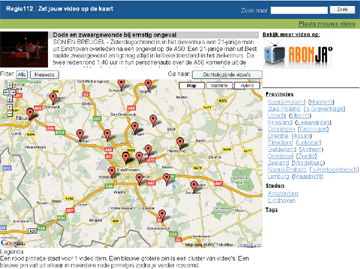Customize your map
May 28th, 2007
When you want to place a Regio112 Map on your site, you can use HTML embedded code directly from the regio112 website.
Here’s an example of the area Eindhoven:
<iframe src=”http://www.regio112.nl/maps/embed?zoom=11&lat=51.44&lng=5.48” width=”400px” height=”400px”>The default is to show all the video items. You can further customize this.
Keyword filtering
If you only want to show video items with a certain tag, e.g. ‘fire, police, ambulance, sq_vision, anything’ you add another parameter (the text in bold) to the HTML embed code.
<iframe src=”http://www.regio112.nl/maps/embed?zoom=11&lat=51.44&lng=5.48 &q=meta%5Bkeyword%5D%3Dsq_vision” width=”400px” height=”400px”>
Map dimensions
Changing the size is just as easy. The width and height parameters are set by default to 400 pixels. Here’s an example of a rectangular view.
<iframe src=”http://www.regio112.nl/maps/embed?zoom=11&lat=51.44&lng=5.48 &q=meta%5Bkeyword%5D%3Dsq_vision” width=”300px” height=”800px”>Embed Google Maps
May 16th, 2007
This HTML embedded code is copied directly from the regio112 website.
Regio112
May 14th, 2007
Regio112 is a site that presents the video’s based on their location. Users are free to upload their own video and place it anywhere on the worldmap!
It’s build with the Whitelabel Video API and it looks like:

Javascript uniq?
May 14th, 2007
protoype
Protoype is a cool javascript framework very usefull for dynamic webapp creation; however, the uniq algorithm in prototype.js is rather slow for large sets, infact it is O(n2) (quadratic).
This happens because uniq does not expects a sorted array and thus all elements are compared to all elements in the array (the array.include does a foreach for each value). And secondly, the array.concat function ‘will yield a new, intermediary array every time it encounters a new value (a value that wasn’t already in the result array)’.
1 2 3 4 5 |
uniq: function() { return this.inject([], function(array, value) { return array.include(value) ? array : array.concat([value]); }); }, |
stl
If you look at the c++ stl (standard template libary), this problem is solved in O(n) (linear) time, so a solution is near: convert a little bit of c++ to javascript!
(Note: there is a jsstl available on the web, but it does not implement the algorithm part of the stl, only the containers & iterators …)
1 2 3 4 5 6 7 8 9 10 11 12 13 14 |
// TEMPLATE FUNCTION unique template<class _FwdIt> inline _FwdIt unique(_FwdIt _First, _FwdIt _Last) { // remove each matching previous for (_FwdIt _Firstb; (_Firstb = _First) != _Last && ++_First != _Last; ) if (*_Firstb == *_First) { // copy down for (; ++_First != _Last; ) if (!(*_Firstb == *_First)) *++_Firstb = *_First; return (++_Firstb); } return (_Last); } |
(The above is Copyright© 1992-2002 by P.J. Plauger.)
solution
This translates fairly forward to:
1 2 3 4 5 6 7 8 9 10 11 12 13 14 15 16 17 18 19 20 21 22 |
// Removes redundant elements from the array function unique_inplace(an_array) { var first = 0; var last = an_array.length; for(var firstb; (firstb = first) != last && ++first != last; ) { if(an_array[firstb] == an_array[first]) { for(; ++first != last; ) { if (!(an_array[firstb] == an_array[first])) { an_array[++firstb] = an_array[first]; } } ++firstb; an_array.length = firstb; return; } an_array.length = firstb; } |
And this does not take forever on an array of more than 10 elements. It works on the concept of ranges: since the input array is sorted, all similar items will be grouped together; so if we look for the first of a group of similar, we can then skip the others. In the end will we will have an array without the doubles.
One last caveat: you will need to sort your array before you use this function!
